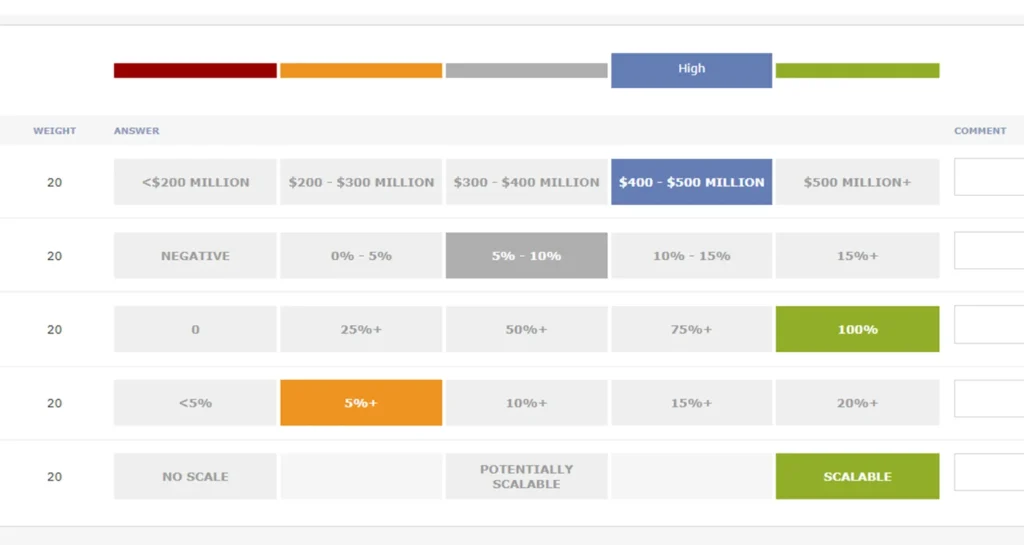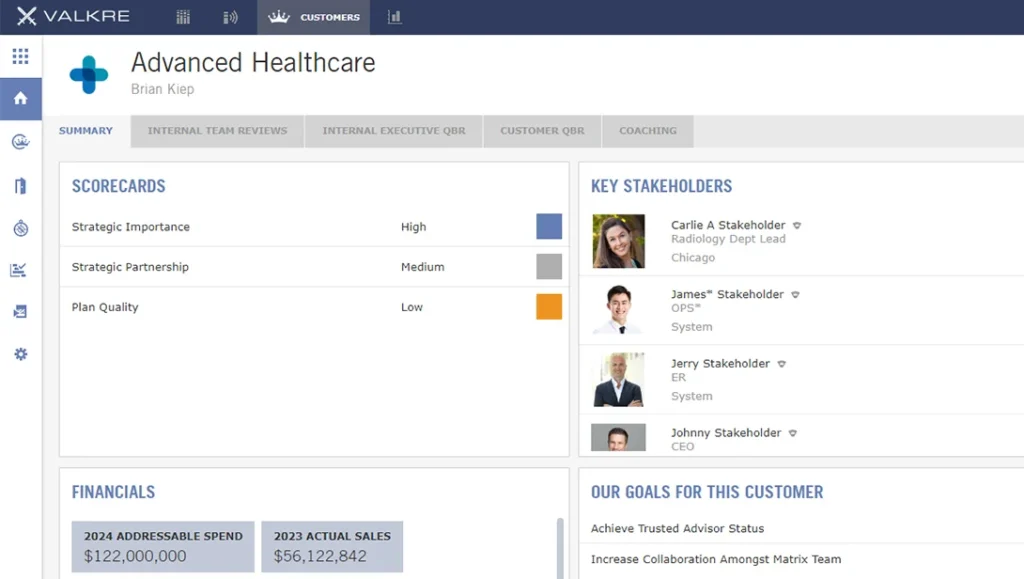SUPPORTING BEST-IN-CLASS KAM PROGRAMS WITH TECHNOLOGY
Key account management (KAM) has evolved into a strategic powerhouse, requiring tools that keep pace with its growing complexity. Adding value to your most important customers means embracing technology for KAM that empowers teams to manage accounts with precision, improve customer engagement, and drive continuous improvement.
Here’s how technology enables modern KAM programs to thrive:
Efficiency and Agility
Modern KAM tools consolidate data and automate workflows, allowing account managers to access relevant information instantly. This reduces time spent on administrative or repetitive tasks and increases time spent on value-driving activities, such as building relationships with customer business leaders and identifying growth opportunities.
Enhanced Customer Experience
AI-powered tools like co-pilots and real-time dashboards provide account managers with personalized insights, helping them anticipate customer service needs and deliver proactive, tailored experiences. By consistently exceeding customer expectations, key account managers strengthen partnerships and improve loyalty.
Data-Driven Strategy
The days of relying on guesswork are over. AI-driven analytics provide visibility into key account performance, helping KAM teams identify patterns, risks, and opportunities. This data-first approach enables proactive account management that drives long-term growth and value.
EMBRACING TECHNOLOGY: A COMPETITIVE IMPERATIVE
Traditional, fragmented processes no longer meet the demands of modern KAM programs. The most successful organizations have embraced technology for KAM to unify data, streamline processes, and deliver valuable insights.
Transitioning to a technology-driven KAM solution doesn’t happen overnight. It starts with a clear assessment of your current tools and processes. This will identify areas where new technology can enhance efficiency and improve results.
TRANSITIONING TO A MODERN KAM SOLUTION: PRACTICAL STEPS FOR SUCCESS
Moving to a modern KAM platform begins with evaluating your current systems and understanding the unique needs of your key account program. Here’s how to make that transition smoothly:
Evaluate Current Technology and Processes
Identify where your current system falls short—whether in data integration, workflow automation, or real-time insights—and pinpoint areas for improvement.
Define Key Requirements
Outline what your KAM program needs to be successful. Prioritize capabilities like AI-driven insights, real-time dashboards, and integrated playbooks to guide your technology selection.
Explore Specialized KAM Platforms
Generic CRM tools aren’t enough. Look for purpose-built KAM solutions that address the specific challenges of managing strategic accounts and empower your team to drive meaningful outcomes.
LEVERAGING AI IN KEY ACCOUNT MANAGEMENT: THE FUTURE OF KAM IS HERE
Integrating AI in key account management is reshaping how organizations manage their most valuable customers. As a discipline built on data and strategy, KAM is perfectly positioned to benefit from AI-driven tools that enhance decision-making, increase operational efficiency, and improve the overall customer experience.
From real-time insights to predictive recommendations, AI-powered solutions—like co-pilots—offer KAM leaders the competitive edge needed to grow strategic relationships and drive lasting success.
HOW AI TRANSFORMS KEY ACCOUNT MANAGEMENT
AI doesn’t just make account management faster; it makes it smarter. Here are three key ways AI is revolutionizing KAM:
1. Strategic Insights at Scale
AI empowers KAM teams to analyze large volumes of account data, offering a holistic view across an entire portfolio. These data-driven insights help uncover trends, identify new cross-sell and upsell opportunities, and predict potential risks—allowing KAM leaders to act before issues arise.
For example, AI can detect patterns in customer behavior, alerting account managers to proactive engagement opportunities that may have otherwise gone unnoticed. This strategic foresight improves both customer retention and revenue growth.
2. Suggested Actions Based on Success
One of AI’s most valuable features is its ability to learn from past successes. AI can provide key account managers with tailored recommendations to replicate those winning strategies across their portfolio by analyzing what has worked well in similar accounts.
Imagine your KAM tool suggesting a cross-selling campaign based on tactics that drove results in a comparable account. This data-backed guidance enables teams to move confidently, knowing they’re applying proven approaches to their most important relationships.
3. Visibility into Program Health
AI-driven analytics provide ongoing visibility into the health of your KAM program. From individual account performance to overall strategy effectiveness, these insights help leaders assess what’s working and what needs adjustment.
By continuously optimizing account plans and adjusting strategies in real-time, KAM teams can shift from reactive management to proactive planning—anticipating customer needs and making faster, more informed decisions.
KAM DATA & AI CO-PILOTS: THE KEY TO ACTIONABLE INSIGHTS
The power of AI in key account management starts with centralized data collection. Bringing all your key account information into a cohesive dataset creates a goldmine of insights that AI co-pilots can analyze to provide real-time recommendations.
With this unified data set, an AI co-pilot can:
- Identify emerging trends and potential risks.
- Surface cross-sell and upsell opportunities.
- Deliver actionable guidance directly to KAMs for smarter decision-making.
By transforming raw data into actionable insights, AI co-pilots empower teams to move beyond manual processes and embrace data-driven strategies that improve account outcomes.
OVERCOMING AI ADOPTION CHALLENGES IN KEY ACCOUNT MANAGEMENT
Embracing AI in key account management promises significant improvements in operational efficiency, customer engagement, and data-driven strategy. However, like any transformative technology, AI comes with its own challenges that organizations must navigate to ensure successful adoption. From team resistance to data issues and system integration concerns, addressing these obstacles proactively can make or break the success of your AI-driven KAM initiatives.
Here’s a look at the key challenges organizations face when implementing AI in KAM—and practical steps to overcome them.
1. Team Resistance: Building Trust in AI Tools
One of the most common barriers to AI adoption is resistance from account managers and teams who may be unfamiliar with the technology or hesitant to change existing workflows. Many fear AI will replace human roles or add unnecessary complexity to their day-to-day tasks.
Solution: Focus on Change Management and Education
- Start with education and transparency. Communicate how AI will enhance—not replace—their roles by automating repetitive tasks, providing real-time insights, and helping them focus on strategic activities that drive customer value.
- Involve teams early in the process. Include key account managers in selecting, customizing, and testing AI tools to ensure their concerns are addressed and feedback is incorporated.
- Provide hands-on training and support. Implement a comprehensive onboarding program focusing on the practical benefits of AI tools, such as improving account planning, customer interactions, and overall efficiency.
2. Data Quality and Availability: The Foundation for AI Success
AI tools are only as effective as the data they analyze. Incomplete, outdated, or siloed data can limit the accuracy and usefulness of AI-driven insights, resulting in unreliable recommendations and missed opportunities.
Solution: Centralize and Cleanse Data
- Consolidate data into a centralized platform. Use a purpose-built KAM tool like Valkre to bring all key account information into one cohesive dataset, ensuring AI has access to the full picture.
- Prioritize data quality. Implement regular data audits to ensure your account data is accurate, complete, and current. Address gaps and inconsistencies before deploying AI tools.
- Leverage data integration capabilities. Ensure your AI tools can pull data from multiple sources, such as CRMs, financial systems, and customer support platforms, to create a comprehensive view of each account.
3. Integration with Existing Systems: Ensuring Seamless Adoption
Many organizations worry that introducing new AI tools will disrupt their existing technology stack or create friction with current processes. The challenge lies in ensuring that AI solutions integrate smoothly with CRM platforms, reporting tools, and other business systems without causing downtime or additional workload for IT teams.
Solution: Choose Flexible, Purpose-Built Solutions
- Opt for purpose-built KAM platforms. Unlike generic CRM add-ons, specialized KAM tools like Valkre are designed to integrate seamlessly with existing systems, reducing the risk of disruptions.
- Start small and scale up. Begin with a phased rollout, focusing on a small group of accounts or users to test the integration and gather feedback before expanding across the organization.
- Ensure IT involvement. Engage your IT team early to address security or compatibility concerns and streamline the integration process.
Practical Tips for Smooth AI Adoption in KAM
To make the transition to AI-powered key account management as smooth as possible, follow these best practices:
- Align on business goals. Ensure that your AI implementation is directly tied to your KAM program’s goals, such as improving customer engagement, reducing churn, or increasing upsell opportunities.
- Set clear success metrics. Define measurable KPIs—such as time saved on account planning or customer satisfaction scores—to track the impact of your AI tools and ensure they deliver value.
- Provide ongoing support. AI adoption isn’t a one-and-done effort. Offer continuous training, gather feedback, and make iterative improvements to ensure teams remain engaged and confident in using the tools.
By addressing these challenges head-on, organizations can unlock the full potential of AI-driven KAM technology, ensuring a smoother transition and maximizing the value of their investments. With the right change management strategies and tools in place, AI becomes an enabler of growth, efficiency, and stronger customer relationships.
UNLOCK THE FUTURE OF KAM WITH AI-POWERED TOOLS
The future of key account management lies in embracing advanced technology that drives operational efficiency, improves customer engagement, and provides actionable insights through AI-driven tools.
With the support of well-deployed technology tools, key account managers move from reactive to proactive strategies, shifting their focus from managing routine tasks to driving long-term growth and value for their key accounts.
The time to evolve your KAM approach is now. Reach out to see how Valkre can help your key account management team with purpose-built technology and AI-driven solutions. With the right tools in place, your team will be equipped to build stronger partnerships, unlock new opportunities, and deliver exceptional customer experiences.



